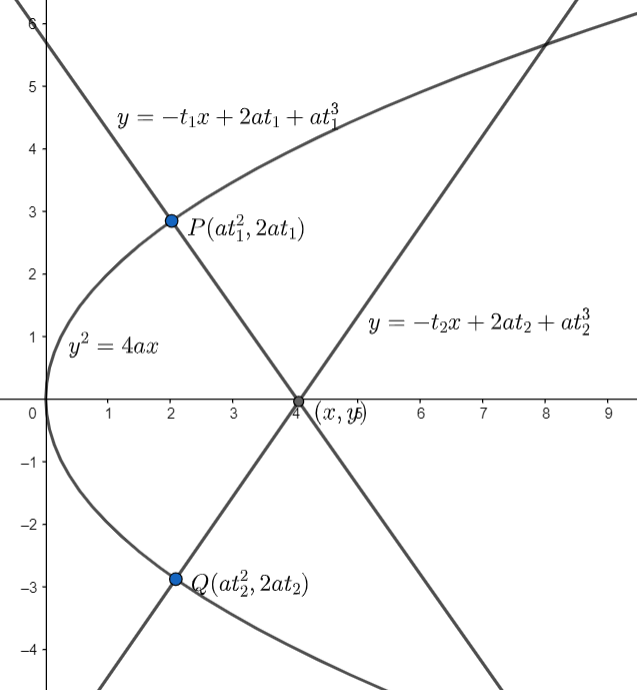
Find the point of intersection of normals at $P\left( {{t}_{1}} \right)$ and $Q\left( {{t}_{2}} \right)$ on the parabola ${{y}^{2}}=4ax$ .
Answer
596.1k+ views
Hint: The given problem is related to the equation of normal to parabola in parametric form. The general equation of the normal to the parabola at a point \[\left( a{{t}^{2}},2at \right)\] is given by \[y=-tx+2at+a{{t}^{3}}\] , where \[t\] is a parameter.
Complete step-by-step answer:
We are given the equation of the parabola as \[{{y}^{2}}=4ax\] .
Now, we will consider two points on the parabola given by \[P\left( at_{1}^{2},2a{{t}_{1}} \right)\] and \[Q\left( at_{2}^{2},2a{{t}_{2}} \right)\] , where \[{{t}_{1}}\] , and \[{{t}_{2}}\] are parameters.

Now, we need to find the equation of normal at \[P\] and \[Q\] .
We know, the general equation of the normal to the parabola at a point \[\left( a{{t}^{2}},2at \right)\] is given by \[y=-tx+2at+a{{t}^{3}}\] , where \[t\] is a parameter.
So, the normal to the parabola at the point \[P\left( at_{1}^{2},2a{{t}_{1}} \right)\] will be given is given by substituting \[{{t}_{1}}\] in place of \[t\] in the general equation of the normal.
On substituting \[{{t}_{1}}\] in place of \[t\] in the general equation of the normal, we get \[y=-{{t}_{1}}x+2a{{t}_{1}}+at_{1}^{3}....\left( i \right)\] .
And the normal to the parabola at the point \[Q\left( at_{2}^{2},2a{{t}_{2}} \right)\] is given as \[y=-{{t}_{2}}x+2a{{t}_{2}}+at_{2}^{3}....\left( ii \right)\] .
Now, to find the point of intersection of \[\left( i \right)\] and \[\left( ii \right)\] , we substitute the value of \[y\] from equation \[\left( i \right)\] in equation \[\left( ii \right)\] .
On substituting the value of \[y\] from equation \[\left( i \right)\] in equation \[\left( ii \right)\] , we get \[-{{t}_{1}}x+2a{{t}_{1}}+at_{1}^{3}=-{{t}_{2}}x+2a{{t}_{2}}+at_{2}^{3}\] .
\[\Rightarrow \left( {{t}_{2}}-{{t}_{1}} \right)x=2a\left( {{t}_{2}}-{{t}_{1}} \right)+a\left( t_{2}^{3}-t_{1}^{3} \right)\]
\[\Rightarrow \left( {{t}_{2}}-{{t}_{1}} \right)x=2a\left( {{t}_{2}}-{{t}_{1}} \right)+a\left( {{t}_{2}}-{{t}_{1}} \right)\left( t_{1}^{2}+t_{2}^{2}+{{t}_{1}}{{t}_{2}} \right)\]
\[\Rightarrow x=2a+a\left( t_{1}^{2}+t_{2}^{2}+{{t}_{1}}{{t}_{2}} \right)\]
Now, we will substitute \[x=2a+a\left( t_{1}^{2}+t_{2}^{2}+{{t}_{1}}{{t}_{2}} \right)\] in equation \[\left( i \right)\] .
On substituting \[x=2a+a\left( t_{1}^{2}+t_{2}^{2}+{{t}_{1}}{{t}_{2}} \right)\] in equation \[\left( i \right)\] , we get \[y=-{{t}_{1}}\left( 2a+a\left( t_{1}^{2}+t_{2}^{2}+{{t}_{1}}{{t}_{2}} \right) \right)+2a{{t}_{1}}+at_{1}^{3}\] .
\[=-2a{{t}_{1}}-at_{1}^{3}-at_{2}^{2}{{t}_{1}}-at_{1}^{2}{{t}_{2}}+2a{{t}_{1}}+at_{1}^{3}\]
\[\Rightarrow y=-a{{t}_{1}}{{t}_{2}}\left( {{t}_{1}}+{{t}_{2}} \right)\]
So, the point of intersection of the normal is \[\left( 2a+a\left( t_{1}^{2}+t_{2}^{2}+{{t}_{1}}{{t}_{2}} \right),-a{{t}_{1}}{{t}_{2}}\left( {{t}_{1}}+{{t}_{2}} \right) \right)\] .
Note: While simplifying the equations, please make sure that sign mistakes do not occur. These mistakes are very common and can confuse while solving. Ultimately the answer becomes wrong. So, sign conventions should be carefully taken.
Complete step-by-step answer:
We are given the equation of the parabola as \[{{y}^{2}}=4ax\] .
Now, we will consider two points on the parabola given by \[P\left( at_{1}^{2},2a{{t}_{1}} \right)\] and \[Q\left( at_{2}^{2},2a{{t}_{2}} \right)\] , where \[{{t}_{1}}\] , and \[{{t}_{2}}\] are parameters.

Now, we need to find the equation of normal at \[P\] and \[Q\] .
We know, the general equation of the normal to the parabola at a point \[\left( a{{t}^{2}},2at \right)\] is given by \[y=-tx+2at+a{{t}^{3}}\] , where \[t\] is a parameter.
So, the normal to the parabola at the point \[P\left( at_{1}^{2},2a{{t}_{1}} \right)\] will be given is given by substituting \[{{t}_{1}}\] in place of \[t\] in the general equation of the normal.
On substituting \[{{t}_{1}}\] in place of \[t\] in the general equation of the normal, we get \[y=-{{t}_{1}}x+2a{{t}_{1}}+at_{1}^{3}....\left( i \right)\] .
And the normal to the parabola at the point \[Q\left( at_{2}^{2},2a{{t}_{2}} \right)\] is given as \[y=-{{t}_{2}}x+2a{{t}_{2}}+at_{2}^{3}....\left( ii \right)\] .
Now, to find the point of intersection of \[\left( i \right)\] and \[\left( ii \right)\] , we substitute the value of \[y\] from equation \[\left( i \right)\] in equation \[\left( ii \right)\] .
On substituting the value of \[y\] from equation \[\left( i \right)\] in equation \[\left( ii \right)\] , we get \[-{{t}_{1}}x+2a{{t}_{1}}+at_{1}^{3}=-{{t}_{2}}x+2a{{t}_{2}}+at_{2}^{3}\] .
\[\Rightarrow \left( {{t}_{2}}-{{t}_{1}} \right)x=2a\left( {{t}_{2}}-{{t}_{1}} \right)+a\left( t_{2}^{3}-t_{1}^{3} \right)\]
\[\Rightarrow \left( {{t}_{2}}-{{t}_{1}} \right)x=2a\left( {{t}_{2}}-{{t}_{1}} \right)+a\left( {{t}_{2}}-{{t}_{1}} \right)\left( t_{1}^{2}+t_{2}^{2}+{{t}_{1}}{{t}_{2}} \right)\]
\[\Rightarrow x=2a+a\left( t_{1}^{2}+t_{2}^{2}+{{t}_{1}}{{t}_{2}} \right)\]
Now, we will substitute \[x=2a+a\left( t_{1}^{2}+t_{2}^{2}+{{t}_{1}}{{t}_{2}} \right)\] in equation \[\left( i \right)\] .
On substituting \[x=2a+a\left( t_{1}^{2}+t_{2}^{2}+{{t}_{1}}{{t}_{2}} \right)\] in equation \[\left( i \right)\] , we get \[y=-{{t}_{1}}\left( 2a+a\left( t_{1}^{2}+t_{2}^{2}+{{t}_{1}}{{t}_{2}} \right) \right)+2a{{t}_{1}}+at_{1}^{3}\] .
\[=-2a{{t}_{1}}-at_{1}^{3}-at_{2}^{2}{{t}_{1}}-at_{1}^{2}{{t}_{2}}+2a{{t}_{1}}+at_{1}^{3}\]
\[\Rightarrow y=-a{{t}_{1}}{{t}_{2}}\left( {{t}_{1}}+{{t}_{2}} \right)\]
So, the point of intersection of the normal is \[\left( 2a+a\left( t_{1}^{2}+t_{2}^{2}+{{t}_{1}}{{t}_{2}} \right),-a{{t}_{1}}{{t}_{2}}\left( {{t}_{1}}+{{t}_{2}} \right) \right)\] .
Note: While simplifying the equations, please make sure that sign mistakes do not occur. These mistakes are very common and can confuse while solving. Ultimately the answer becomes wrong. So, sign conventions should be carefully taken.
Recently Updated Pages
Why are manures considered better than fertilizers class 11 biology CBSE

Find the coordinates of the midpoint of the line segment class 11 maths CBSE

Distinguish between static friction limiting friction class 11 physics CBSE

The Chairman of the constituent Assembly was A Jawaharlal class 11 social science CBSE

The first National Commission on Labour NCL submitted class 11 social science CBSE

Number of all subshell of n + l 7 is A 4 B 5 C 6 D class 11 chemistry CBSE

Trending doubts
What is meant by exothermic and endothermic reactions class 11 chemistry CBSE

10 examples of friction in our daily life

One Metric ton is equal to kg A 10000 B 1000 C 100 class 11 physics CBSE

1 Quintal is equal to a 110 kg b 10 kg c 100kg d 1000 class 11 physics CBSE

Difference Between Prokaryotic Cells and Eukaryotic Cells

What are Quantum numbers Explain the quantum number class 11 chemistry CBSE




